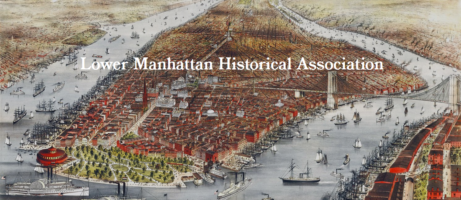
On October 10, 2022, the Lower Manhattan Historical Association (LMHA) resumed its annual in-person “Alexander Hamilton Immigrant Achievement Awards Ceremony” after the COVID hiatus. The ceremony was held at Trinity Commons, the new facility of Trinity Church in Manhattan located on a bridge walkway from Church. It provides a spectacular view the Trinity Church and is a wonderful facility to hold an event in lower Manhattan.
The awards this year were awarded to (in alphabetical order):
Michael Arad (Israel): the designer of the National September 11 Memorial at the World Trade Center site titled “Reflecting Absence.” His design was selected by the Lower Manhattan Development Corporation from among over 5000 submissions. He subsequently worked on fulfillment of his architectural vision.
Manuel Castro (Mexico): Commissioner in the Mayor’s Office of Immigrant Affairs. He is responsible for running the New York City agency dedicated to supporting over 3.2 million immigrants in New York City. Previously during COVID, he was the executive Director of New Immigrant Community Empowerment (NICE).
Wellington Chen (Formosa, Hong Kong): He is an architect by training and has a life-long interest in community resuscitation. He is the executive director of the Chinatown Partnership Local Development Corporation and serves on a range of organizations encompassing political, economic, and social areas.
I was asked to speak (for four minutes) on the importance of immigration. Below is my talk.
Today we salute Alexander Hamilton for helping to establish the country that would permit millions of other immigrants to fulfill the American dream.
I would like to begin with the story of one such family … mine. About one century ago, my father’s family arrived in the here from Russian-occupied Latvia. Sound familiar?
My grandfather had first come here several years earlier to avoid the Russian draft. Sound familiar?
He subsequently returned home, married, started a family, and left again. When the family arrived with my father they settled in Eagle Pass, Texas. Perhaps you heard of it recently. Later they relocated to New York. This means my family may be the first immigrant family to travel from Eagle Pass to New York.
Now here we are a century later. What has changed?
Or as the son of Italian-American immigrants said: “It’s déjà vu all over again.”
By now, I am sure you have the pictures of Russians fleeing Putin’s partial mobilization and war. As I looked at those scenes of longlines of cars, I was reminded of another scene of longlines of cars, only this one to fulfill the American Dream.
The scene is from the ending of the movie Field of Dreams. The cars are heading for a mythical baseball field in a field of corn. There Kevin Costner is playing catch with his deceased father. The father asks, “Is this heaven?’ The son replies, “It’s Iowa.” The father looks around and says, “I could have sworn this was heaven.” Kevin asks his father, “Is there a heaven?” Dad answers, “Oh yeah. It’s the place dreams come true.” The son looks around and sees his family, his home, and his farm and says, “May be this is heaven.” Grown men have be known to weep at this scene.
Closer to where we are today, there is another cinematic attestation of the cosmic fulfillment of the American Dream at a City on a Hill. I am referring, of course, to the scene from Working Girl. Melanie Griffith is taking the Staten Island ferry to New York. She sees before her not the Iowa farm but the city of Manhattan. She sees Lower Manhattan with the World Trade Towers. She sees the Statue of Liberty. She does so to the sound of Carly Simon singing
Let the river run
Let all the dreamers
Wake the nation
Come, the New Jerusalem.
New York is the island at the center of the world.
New York is the cosmic center.
New York is the City on a Hill.
New York is where dreams come true.
From the Jews who arrived in 1654 to the Irish at Castle Garden to the Great Migration, New York has been a beacon light for centuries even before the torch of Lady Liberty shone.
If the Lower Manhattan Historical Association granted awards to all the immigrants to this land who have fulfilled the American Dream, we would be here for years.
We must recognize that the dream has not been fulfilled for all who have come here or have been brought here or have been born here.
We must recognize that there still is much work to be done before that vision can be fulfilled.
But we also should take time to recognize and salute those who have succeeded.
It is with that vision in mind that the Lower Manhattan Historical Association is proud to grant the Alexander Hamilton Immigrant award to this year’s awardees.






